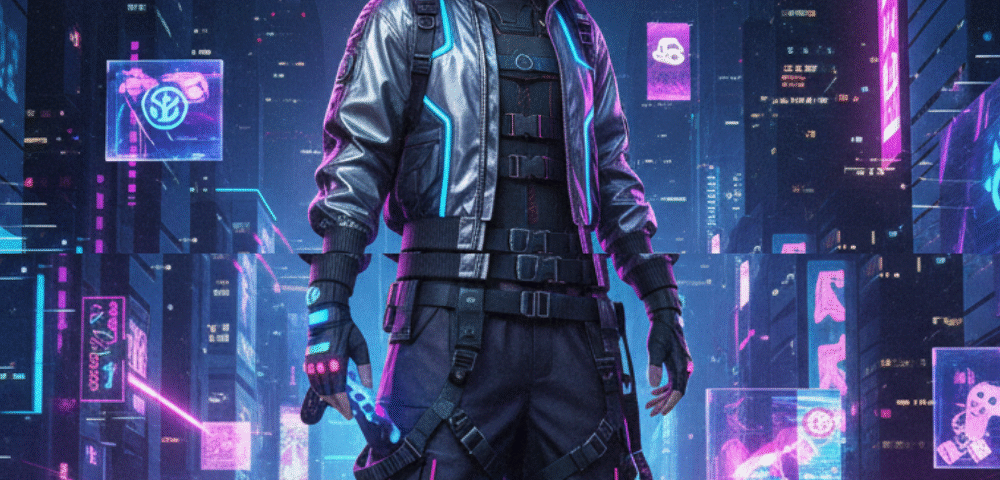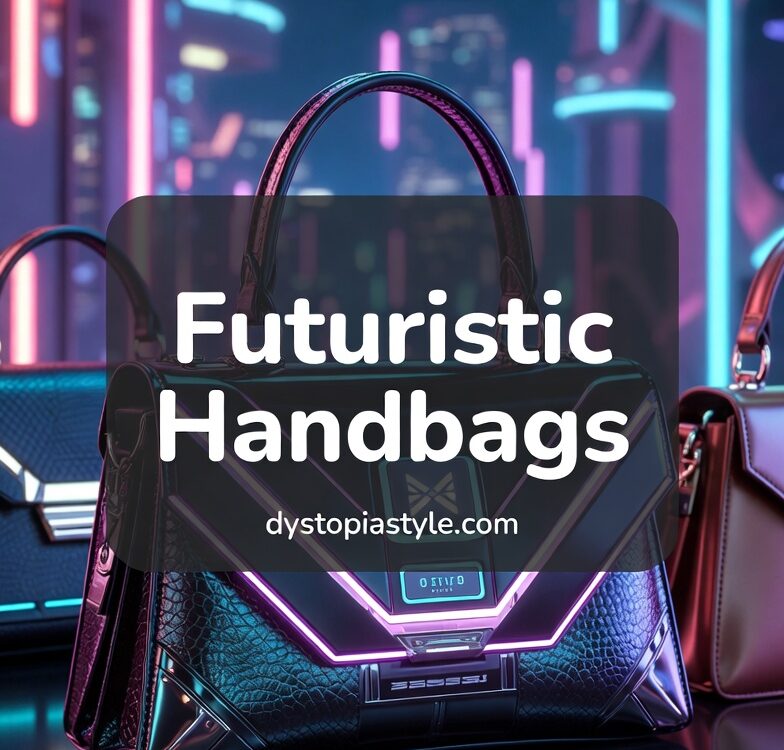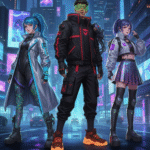
Exploring Anime Futuristic Fashion: Where Sci-Fi Meets Street Style
October 6, 2025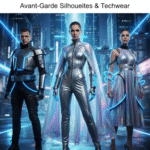
Futuristic Movie Fashion: Iconic Sci-Fi Styles and Their Lasting Impact on Real-World Trends
October 7, 2025In the ever-evolving landscape of style and technology, futuristic gaming fashion stands out as a captivating fusion of digital innovation and wearable art. As we dive into 2025, this niche has exploded from niche gamer wardrobes into mainstream culture, influenced by immersive virtual realities, cyberpunk narratives, and esports dominance. Futuristic gaming fashion isn’t just about looking cool while streaming—it’s a statement of identity, blending high-tech materials with bold, sci-fi-inspired designs that echo the worlds of games like Cyberpunk 2077 or Fortnite.
What makes futuristic gaming fashion so appealing? It’s the seamless integration of functionality and flair. Gamers demand apparel that supports long sessions with breathable fabrics, ergonomic fits, and even embedded tech like LED lights or smart sensors. But beyond practicality, it’s about self-expression. From holographic jackets that shift colors to liquid-metal dresses that ripple with movement, these pieces draw from gaming universes to create outfits that feel otherworldly yet accessible. As Gen Z leads the charge, preferring sleek, monochromatic looks in black, gray, and white, futuristic gaming fashion embodies a forward-thinking ethos that’s sustainable, inclusive, and endlessly customizable.
This article explores the roots, elements, brands, and trends shaping futuristic gaming fashion today. Whether you’re a hardcore esports fan or a casual player dipping into streetwear, discover how this trend is redefining what we wear in both virtual and physical realms.
The Evolution of Gaming Fashion: From Pixels to Runways
The journey of futuristic gaming fashion traces back to the early days of video games in the 1970s and 1980s, when arcades birthed a subculture of enthusiasts clad in simple tees and jeans. Back then, fashion was secondary to the gameplay, but icons like Pac-Man and Pong sparked the first waves of merchandise—basic logos on caps and shirts that hinted at a budding identity. As technology advanced in the 1990s, games like The Sims introduced dress-up mechanics, allowing players to experiment with virtual outfits and blurring the lines between gaming and style.
By the 2010s, the rise of esports and streaming platforms like Twitch propelled gaming into a global phenomenon. Fashion followed suit, with collaborations between game developers and designers creating limited-edition drops. Think Louis Vuitton’s League of Legends collection or Gucci’s partnerships in Roblox—sudden bursts of luxury infused with pixelated charm. This era marked the shift toward futuristic gaming fashion, where cyberpunk elements like neon accents and techwear became staples.
Entering the 2020s, digital fashion exploded with NFTs and metaverses. Avatars in Decentraland or The Sandbox wore virtual garments that mirrored real-world trends, influencing physical apparel. Today, in 2025, futuristic gaming fashion has matured into a hybrid of streetwear and high-tech, with sustainable materials and AR integrations. From Atari’s Pong to hyperrealistic simulations, this evolution reflects how gaming has permeated culture, turning players into style influencers. It’s no longer just about playing games; it’s about living them through what you wear.
Key Elements Defining Futuristic Gaming Fashion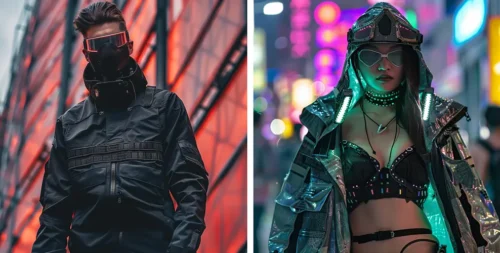
Futuristic gaming fashion thrives on innovation, drawing from sci-fi tropes to create apparel that’s as practical as it is visually striking. At its core are materials like smart fabrics that adapt to temperature or embed LEDs for customizable lighting—perfect for late-night raids or urban outings. Think bodysuits with holographic patterns that change based on movement, echoing the dynamic environments of virtual worlds.
Color palettes play a huge role: monochromatic schemes dominate for a sleek, cyberpunk vibe, but 2025 sees subtle pastels and bright accents creeping in, especially in accessories like RGB-lit sneakers. Functionality is key—ergonomic designs with moisture-wicking properties ensure comfort during extended play, while modular pieces allow for personalization, much like customizing a game character.
Accessories elevate the look: Visors inspired by VR headsets, gloves with tactile feedback, and backpacks with charging ports blend utility with aesthetics. Sustainability is emerging strongly, with eco-friendly fabrics from recycled plastics aligning with gamers’ growing environmental consciousness.
In essence, futuristic gaming fashion merges form and function, allowing wearers to embody their favorite game avatars in real life. It’s about pushing boundaries, where clothing becomes an extension of one’s digital persona.
Top Brands Pioneering Futuristic Gaming Fashion
Several brands are at the forefront of futuristic gaming fashion, blending techwear with gaming motifs. Rick Owens leads with avant-garde designs featuring asymmetrical cuts and metallic finishes, ideal for a post-apocalyptic gamer aesthetic. Hamcus offers cyberpunk staples like tactical jackets with multiple pockets, perfect for esports pros.
Japanese influences shine through brands like Acronym and Goopimade, known for high-tech fabrics and minimalist futurism. For official merch, Insert Coin delivers video game-inspired tees and hoodies with a futuristic twist, while ASUS ROG’s apparel line includes reflective, sci-fi prints on comfortable cotton.
Emerging labels like OFF-WRLD and Damascus Apparel push boundaries with LED-embedded garments and sustainable techwear. These brands collaborate with games for limited drops, creating buzz and exclusivity. Whether luxury or street-level, they make futuristic gaming fashion accessible to all.
2025 Trends in Futuristic Gaming Fashion
As we hit 2025, futuristic gaming fashion is all about integration and sustainability. Collaborations between gaming giants and streetwear brands are surging, yielding drops like ergonomic chairs paired with matching apparel or RGB keyboards influencing accessory designs. Aquatic and boho elements mix with tech, but the core remains sleek: hot pants as minis, yellow accents, and suede boho chic infused with holographics.
Adaptive clothing with AR features—scan your outfit for virtual try-ons—is gaining traction. Gaming archives inspire retro-futurism, blending nostalgic designs with modern tech. Overall, trends emphasize personalization, eco-friendliness, and seamless real-virtual blending.
Incorporating Futuristic Gaming Fashion into Your Wardrobe
Start small: Add a holographic jacket or LED sneakers to everyday outfits for a subtle nod to futuristic gaming fashion. Mix with streetwear—pair tactical pants with graphic tees from games like Overwatch.
For full immersion, invest in modular pieces from brands like Reindee Lusion. Layer for versatility: A smart bodysuit under a cyberpunk coat works for gaming marathons or nights out.
Sustainability tip: Opt for recycled materials. Experiment in virtual spaces first via apps, then translate to real life. Futuristic gaming fashion is about confidence—wear it your way.
FAQs on Futuristic Gaming Fashion
What is futuristic gaming fashion? It’s apparel inspired by sci-fi games, featuring tech elements like LEDs and smart fabrics for style and function.
Are there affordable options? Yes, brands like Numskull offer budget-friendly merch, while high-end like Rick Owens cater to luxury seekers.
How sustainable is it? Many trends focus on eco-materials, reducing fashion’s environmental impact.
Can I wear it daily? Absolutely—subtle pieces blend into casual wear, while bold ones suit events.
What’s next in 2026? Expect more AR integrations and AI-customized designs.
Final Words
Futuristic gaming fashion represents the ultimate convergence of play and style, empowering individuals to craft identities that transcend screens. As technology advances, this trend will only grow, making the future of fashion as exciting as the games that inspire it. Embrace it—your wardrobe’s next level awaits.


